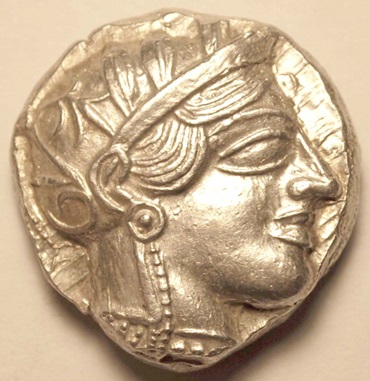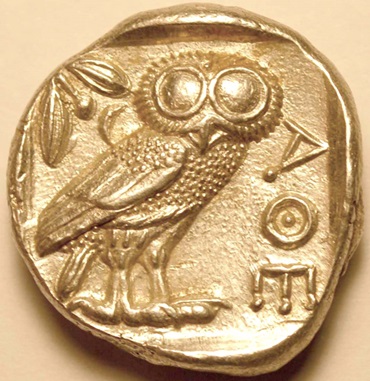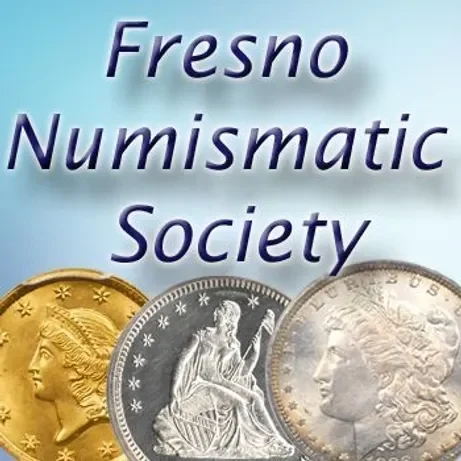The Fresno Numismatic Society hosted our annual Coin Show on October 23 and 24, 2020. As usual, we had an excellent group of dealers who offered a great variety of coins and currency. I spotted an exceptional coin in the display case of dealer Glen Schinke. It is an Athens Attica silver tetradrachm from ancient Greece. This coin is popularly known as an “owl” because of the owl figure that dominates the reverse side. I have been aware of this coin ever since my parents picked up a brass replica piece at the New York Natural History Museum in about 1964. It only took 56 years, but I finally have one to call my own. Even though it’s over 2400 years old, it is extremely well-made and well-preserved. Here are some photos of this wonderful coin.


Obverse
Reverse
The Owl is perhaps the most iconic and famous of all ancient coins. It represented about one week’s pay for a soldier in ancient Greece and was minted in huge numbers in various forms, for several hundred years. It is regarded as the first successful international coin, widely recognized and accepted throughout the ancient world. The silver tetradrachm is widely believed to the type of coin given to Judas for the betrayal of Jesus. Legend has it that President Theodore Roosevelt carried an Owl coin and that it was in part the inspiration for Roosevelt’s interest in redesigning American coinage.
The Owl is pictured on the 1-euro coin of modern Greece and remains a symbol of the Greek city of Athens. The images on both sides of the coin refer to the goddess Athena. The obverse features the head of the goddess. She wears an ornate earring and Attic helmet adorned with olive leaves. The reverse shows the Athenian owl which represents Athena. The actual owl species depicted on the coins is believed to be the “little owl” (scientific name Athene noctua) which is native to the Mediterranean region.
The reverse legend reads AƟE (alpha-theta-epsilon). This is an abbreviation which translates to “of the Athenians”. There is a small crescent moon and an olive sprig with one berry. According to mythology, Athena brought the olive tree to Athens as a gift, in order to impress Zeus and outshine rival god Poseidon.
There are three general styles of Owls corresponding to different production dates. The so-called Archaic type was first minted around 515 BC. These are very scarce and expensive and despite their crude manufacturing quality are avidly sought by collectors. The “Classical” Owls were produced in large quantities starting around 465 BC and continuing until the defeat of Athens by Sparta in 404 BC. My coin is a classical-style piece with production date estimated between 449-413 BC by Glen Schinke. Coins minted after 404 BC are called “Late Classical”, were struck on a smaller planchet, and are less popular with collectors.
Beginning around 165 BC “New Style” coins were issued. These coins were struck on wider, thinner planchets and feature major changes to the reverse especially. The owl image remains, but it now perches on an amphora and the fields include a grape bunch, an encircling laurel wreath, and text indicating the issuing magistrate. The magistrate information allows more precise dating of these pieces. Dating for the Archaic and Classical pieces is less certain. Even major auction houses can disagree on dating for these earlier issues.
Owl silver is typically >99% pure. Traces of copper and gold are present, in concentrations of less than 0.25% and 0.04%, respectively. The silver ore was extracted from the Laurion mine complex located near Athens and was refined by smelting and cupellation processes which at the time were likely the most sophisticated in the world. During many decades of operation, the estimated total production of silver from Laurion exceeded 3,000 tons.
It is believed that Owl planchets were prepared by pouring molten silver into molds that were sized to contain the proper amount of metal. Target weight for a finished Owl was about 17.2 grams and most intact Owls in fact weigh between 17.0 and 17.2 grams. The dies were likely made of bronze and were hand-engraved using burins, drills, chisels, and punches. The obverse die was set into an anvil and the planchet placed on the die. The reverse die was then positioned on the planchet and hand-struck with a heavy hammer. The reverse dies tended to wear out faster than the obverses.
Many Owls have test-cuts which were inflicted in ancient times to verify the coins were solid silver, not some plated base metal. Others show countermarks punched in by merchants to confirm the coins were acceptable for commerce. No matter how you slice it, Owls are remarkable, historic, and beautiful coins. I’m happy to finally have one in my collection.
